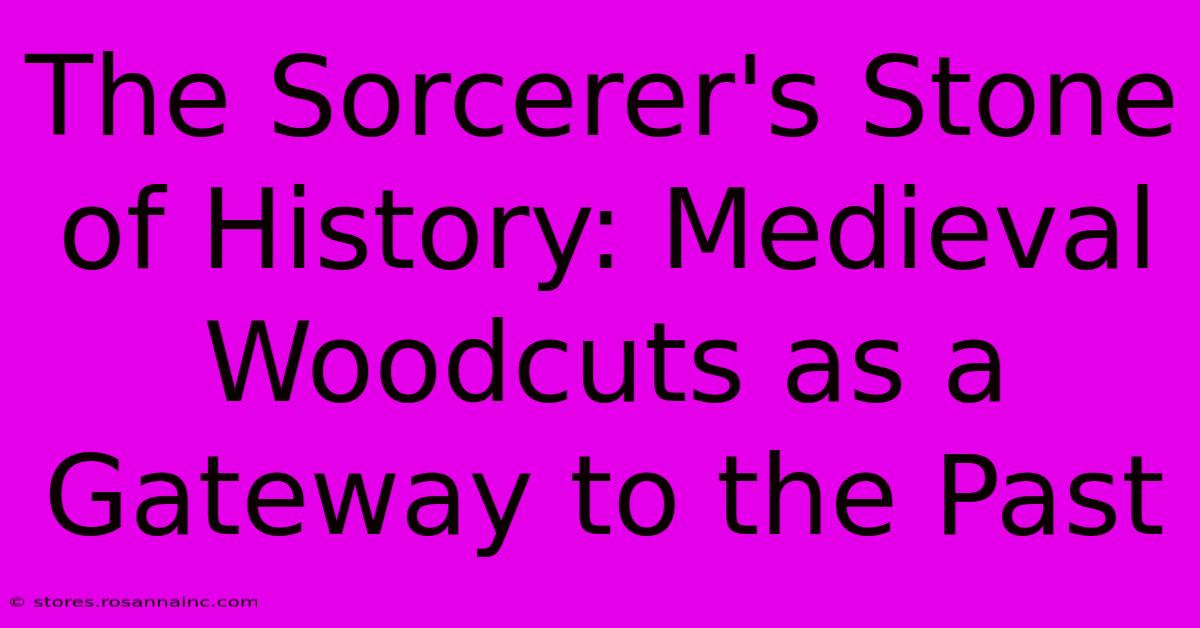The Sorcerer's Stone Of History: Medieval Woodcuts As A Gateway To The Past

Table of Contents
The Sorcerer's Stone of History: Medieval Woodcuts as a Gateway to the Past
Medieval woodcuts. The very phrase conjures images of stark lines, bold contrasts, and a captivating glimpse into a world long gone. More than just simple illustrations, these remarkable prints serve as a sorcerer's stone, transforming humble wood blocks into powerful portals to the medieval past. They offer invaluable insights into daily life, religious beliefs, and the cultural landscape of the era, providing a unique perspective often missing from more formal historical accounts.
A Window into Medieval Life: Beyond the Text
For centuries, the written word dominated historical narratives. However, medieval woodcuts offer a complementary visual narrative, rich in detail and expressive power. Unlike elaborate illuminated manuscripts accessible only to the elite, woodcuts were comparatively inexpensive to produce and disseminate. This meant they reached a wider audience, depicting scenes and concepts that influenced the understanding and beliefs of common people.
Illuminating Daily Life: From Peasant to Prince
These woodcuts aren't just pretty pictures; they're snapshots of daily life. Imagine seeing a woodcut depicting a bustling medieval marketplace, filled with merchants hawking their wares, or a farmer tending his fields. These images offer a powerful sense of immediacy, revealing the texture of everyday medieval life with a starkness that written records often lack. We see the clothing, the tools, the architecture – elements that bring the past vividly to life. Even depictions of royal courts, while often idealized, provide invaluable insights into the rituals, clothing, and power structures of the aristocracy.
Religious Iconography: Faith in Wood and Ink
Religion permeated medieval society, and woodcuts played a crucial role in disseminating religious beliefs and stories. Images of saints, biblical scenes, and allegorical representations of faith were ubiquitous. These woodcuts weren't just artistic representations; they served as powerful tools of religious instruction for a largely illiterate population. By depicting key biblical narratives, they brought the stories of the Bible to life, fostering a deeper understanding and connection with religious teachings. The style, composition, and even the symbolic use of color within these images reveal much about the religious beliefs and practices of the time.
The Art of the Block: Technical Marvels
The creation of a medieval woodcut was a meticulous process. Artists would painstakingly carve the image into a wooden block, often using boxwood for its fine grain. The resulting block was then inked and pressed onto paper, creating a print. The limitations of the medium, such as the use of black and white (or limited color palettes), actually enhanced the expressive power of the image. The stark lines and bold contrasts created a visceral impact, making the scenes depicted unforgettable. Understanding the technical aspects of woodcut production allows for a deeper appreciation of the artistry and skill involved in their creation.
Unlocking the Past: Using Woodcuts in Historical Research
Medieval woodcuts are not simply aesthetically pleasing artifacts; they are vital primary sources for historical research. They provide contextual information that complements written documents, allowing historians to cross-reference and verify details. For example, a woodcut depicting a siege might reveal details about military tactics, weaponry, and the structure of medieval fortifications, which may not be accurately described in contemporary texts. By analyzing the iconography, style, and context of these images, scholars gain a richer and more nuanced understanding of the medieval world.
Beyond the Archive: The Enduring Legacy
The legacy of medieval woodcuts extends far beyond the dusty shelves of archives. Their enduring appeal is evident in their continued use in books, exhibitions, and even digital reproductions. Their bold aesthetics have inspired countless artists and designers, showcasing the enduring power of these seemingly simple images. They remain a powerful testament to the creativity and skill of medieval artisans and offer a unique and accessible gateway to understanding a pivotal period in human history. Studying these woodcuts allows us to connect with the past on a deeply personal level, appreciating the rich tapestry of medieval life and culture in all its complexity. They are, indeed, the sorcerer's stone of historical understanding, turning the past into a vibrant, accessible, and unforgettable experience.

Thank you for visiting our website wich cover about The Sorcerer's Stone Of History: Medieval Woodcuts As A Gateway To The Past. We hope the information provided has been useful to you. Feel free to contact us if you have any questions or need further assistance. See you next time and dont miss to bookmark.
Featured Posts
-
Unleashing The Shadows Side Lightings Role In Creating Unforgettable Movie Moments
Feb 05, 2025
-
Crazy Train Get Ready For The Wild Ride Of 1970s Men In Shorts
Feb 05, 2025
-
Transform Your Nails Into A Mystical Wonderland Dnd Gel Polish Collection Unleashes Magic
Feb 05, 2025
-
Say Goodbye To Sensitive Data Breaches The Ultimate Guide To Vba Redaction
Feb 05, 2025
-
Unlock 50 Savings With Our Exclusive Fifty Flowers Discount Code
Feb 05, 2025
